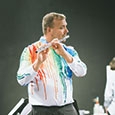Recitals are signature elements of a performing artist’s career. I begin my recital planning process by thinking of the entire production from start to finish as a gift to the audience, a gift to myself, and a gift to the gods of flute. It is important to put forth one’s best efforts into every step of the recital if the recital is to be a success. The desire to create a more interesting recital is an excellent starting point.
Understand the Goal
As programming ideas begin to formulate, remember that sound, especially musical sound, can have many functions. Music is a transformative medium that can entertain, educate, and enrich. A recital may have practical functions as well including promoting a performing and teaching career, meeting degree or university requirements, or even selling tickets. Keeping the purposes of the recital central during planning can bring clarity to programming choices. Sometimes I want to give a thoughtful, diaphanous outpouring of my soul, and other times I simply want to play something flashy or beautiful. Carefully consider why you are giving the recital and what goals you would like to accomplish before selecting music.
Appreciate the Audience
Music is meant to be heard, so I keep the audience in mind during programming and preparation decisions. Without an audience, musicians have little impact on the world. Remember that fun and meaningful ways to spend time are plentiful. Know that your audience has given you the gift of their attention and attendance. Reward them with your best ideas and efforts. Be musically generous and go above and beyond to create an event that will allow them to experience something meaningful.
Consider your own experiences as an audience member as you make decisions. In college, our performing arts ensemble had an artistic night on the town at the beginning of each semester. The cast would go to dinner followed by attending a live performance. These opportunities to watch other artists inspired us to give our best when we performed ourselves. I have adopted this practice for myself and attend concerts by inspiring flutists and musicians as often as possible.
Express Yourself
If you perform music you love, the audience will have the opportunity to experience your passion. Select pieces that reflect your vision and interests. Program music that makes you feel alive. You will know you have chosen well when you lose track of time and space while planning. Select music that makes you feel reckless abandon or want to dance around the kitchen. As you progress as a flutist, your inclinations will naturally change. In my undergraduate days, it was easy for me to gloss over Baroque and contemporary music as not being my thing, but later I discovered the beauty and supreme architecture of the music of Bach and Hindemith. I cannot even fathom how I missed that before.
Music is a communicative art. Con-sider who you are (or aspire to be) as an artist and what you want the audience to experience at the recital. How do you want your listeners to feel? People listen to music because it makes them feel something, so start by selecting music that makes you feel something.
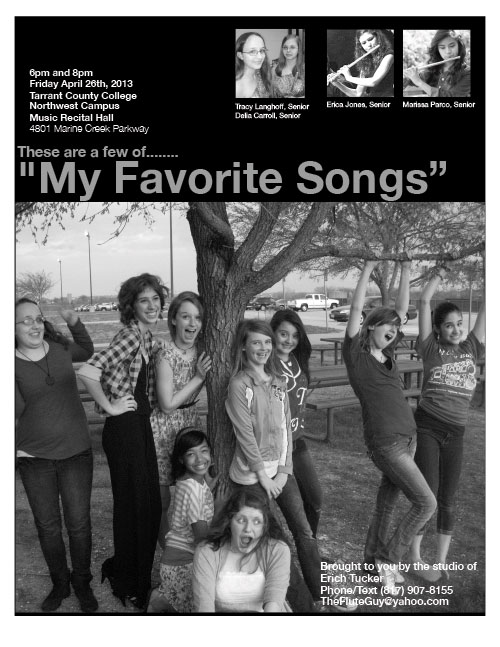
Be Open to Inspiration
Good ideas flow more effortlessly when I am rested and relaxed. On project planning days, I prefer to wake up naturally without an alarm clock, exercise, and then eat a light, healthy snack. This allows me to generate my most creative and usable ideas. I find that complaining rips me out of my creative space, so I try to resolve any impending issues before planning. Keep the creative channel clear. Every person is different, so discover the best ways to bring yourself into the receptive mode.
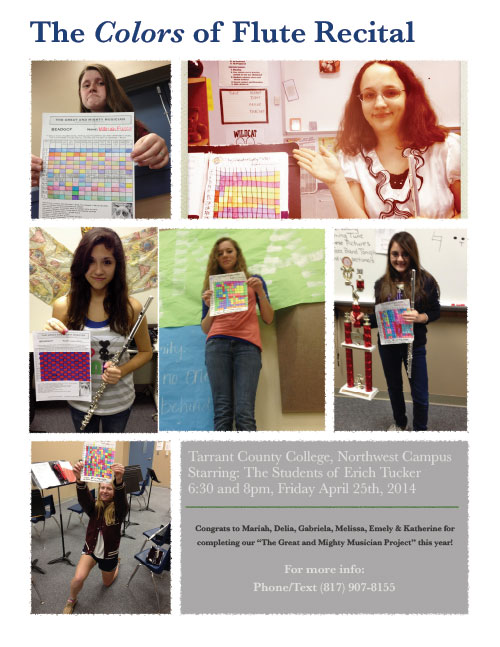
Consider Themed Recitals
Every spring I host a themed studio flute recital. A few favorite ideas have been The Elements of Flute, The Colors of Flute, Heroes and Villains, Animals, Flutes in Wonderland, The Moon and the Sea, My Favorite Things, and The Theatrical Flutist. For the Holidays of the World recital, we performed one piece from each holiday. Students can dress in costume for their performance and even design cupcakes for the reception. After the Hollywood Stars recital (which featured a red carpet and parents disguised as paparazzi), each student received a World’s Best Flutist Academy Award, and we practiced giving award acceptance speeches at lessons the next week.
With the rich and diverse repertoire of flute music available today, it only takes a few moments browsing an online music store or help from a knowledgeable flutist to locate a wealth of recital ideas. YouTube and iTunes search engines can also be valuable resources. You can also find ideas while attending live performances or digging through music at regional and national flute conventions. I periodically ask friends on social media for ideas which has led to a wealth of new programming ideas and has an added benefit of involving future audience members in the idea phase. If all else fails, I invite several of my most creative music colleagues to lunch for a bit of brainstorming. Whenever I have a great recital idea that I am not going to use immediately, I write it down in a notebook for future consideration.
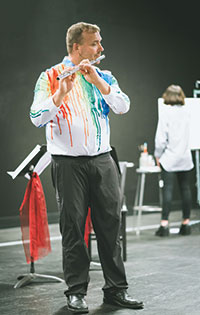
Collaborate with Fascinating Artists
Audiences love innovative connections. My last solo recital included a modern-folk-fusion, improvisatory solo dancer, a visual artist who painted while we performed, and colleagues who performed on voice, flute, piano and cello. One of my favorite performance memories was when I improvised an underscore for Jonah and the Whale at Fort Worth’s Kimball Art Museum in conjunction with the local, funky Hip Pocket Theater. People enjoy watching artists collaborate with each other.
While taking an improvisational theater course at Four Day Weekend (A Second City style training academy), I learned that we are more creative collectively than we are individually. I realized this also applied to music and the flute. Dynamic collaborations bring exciting recital possibilities to the table. In graduate school, I was a member of The Company, an international performing arts troupe which traveled across the U.S., Canada and Europe. Besides being regularly spoiled by the opportunity to collaborate with wildly talented dancers, artists, actors, vocalists, and poets, we learned how to quickly adapt our repertoire to different venues and audiences.
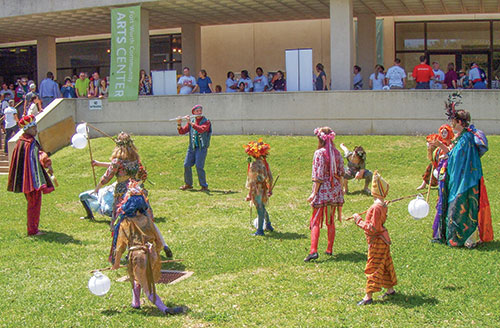
Be Interesting
Artists should strive to live interesting lives and bring those experiences into their music. Allow your natural inclinations to dictate recital programming. Learn to walk through daily life noticing interesting images and ideas, and then save them for when you need them. Know that there is only one of you in all of time and space and learn to tap the vital creative energy that flows through you.
Fill your life with travel, friendships, conversations, podcasts, books, museums, performances, and even television or movies. Inspiration can also be found in the natural world. A well-rounded, diverse education is a great asset. Be curious about your environment and all you encounter. Your natural inclinations will surface in your music, and this will set your work apart from others. Music, as an academic discipline, is a humanity. Allow your humanity to shine through your choices and ultimately in your performances.
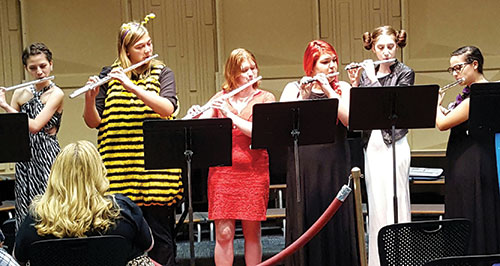
Take Risks
I enjoy growing as an artist and expanding my knowledge. While I prefer much of my solo or chamber recital endeavors to be within my limits as a performer, it can be thrilling to attempt something new or challenging that I am not quite completely sure I can pull off. Stretching past comfort zones can be wildly rewarding and provide opportunities to grow. With the many fantastical modern and experimental flute compositions available today, there are ample opportunities to expand our repertoire. A boat in the harbor is safe, but that is not what boats are made for. Dare to dream big.
Find the Flow
After selecting recital pieces, consider the order in which to perform them. In your production the pieces you have carefully selected will be performed in succession as a cohesive event. Program order and design can make or break a recital. For many years it was common practice to perform works in chronological order. This may not be the best choice. Thoughtful consideration of the program’s flow can delight and surprise listeners.
People tend to remember what they heard first and last, so I prefer to perform my most intriguing or best pieces as the opening and closing numbers. I may start with a showstopper and end with a peaceful, lyrical piece, or the opposite, but either way, I consider the arc of the progression of sound. Sometimes I separate the most harmonically or rhythmically complex pieces to allow the listeners space to process what they have heard. Think about whether similar pieces should go near each other or be separated.
Another consideration is the length of the pieces and whether there should be an intermission. In many cases, a clear-cut order will naturally surface. Think about unusual piece combinations to interest the audience. For example, you could start with a lyrical followed by a technical one, or begin with a sensible standard and then add an experimental work. For each recital I create a playlist of recordings of the pieces and listen to it for several weeks to find the most natural order. Try not to overthink it, and do not overlook the possibility of an encore.
Stay Flexible
Embrace any unexpected changes along the way. Regardless of how well you have planned, a spirit of flexibility will only make everything smoother. The unexpected idiosyncrasies of your recital are part of the show. I believe this is also why recordings, even incredible recordings, will never replace live musical performance. Small or large changes to the recital program may need to be made at some point. Learn how to adapt to make the best choices.
Promote Your Recital
The world will not realize how fantastic your next recital is going to be unless you tell them. I have been to many recitals by high-caliber performing artists with almost nobody in the audience. This breaks my heart. The world is rapidly changing, and if musicians do not adapt to these changes, we may eventually be playing for empty halls.
If you do not have someone to promote your events, get on social media to announce the upcoming project. In just moments you can invite practically everyone you have ever met. With Facebook, Twitter, Instagram, Evite, MailChimp, Pinterest, email, and a few old-fashioned posters, your project can be quickly and stylishly announced to the world.
For my recent Supernatural Flutist recital, I posted promo blurb announcing that Michael Jackson’s Thriller would not be on the program, but I would be performing The Phoenix, which is similar because it is about a zombie bird. The pieces do not sound remotely alike, yet several of these cleverly worded promo blurbs brought more people to the concert than I ever expected. Make sure your potential audience knows what is going to make your performance innovative and exciting.
Word of mouth is also a great way to promote recitals. If you make your recitals truly amazing, your audiences will want to return time and time again. Hopefully the end result of all your hard work will be thrilling performances for audiences who are growing increasingly interested in the musical sounds only you have to offer.
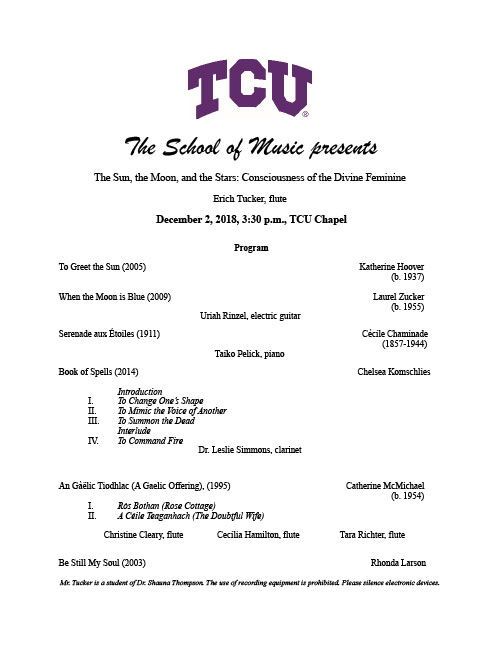
Fortunately the flute repertoire is filled with a rich and diverse collection of magical pieces to consider programming. I wanted to include chamber pieces with my colleagues Allison Stanford, soprano, and Hsinyi Wang, cellist. I also wanted a flute duet to play with a former flute student, MK Raplinger, before she left for graduate school. This narrowed my initial repertoire searches to certain instrumentation. I generated a list of my top 12 ideas and then scaled down to one hour of music with one piece from each major time period.
I opened with Marais’ Les Follies d’Espagne. While the entire recital was not performed in chronological order, this was the oldest piece, the only piece for flute alone, and the only piece I performed from memory. As a result, this felt like a strong opening. The folia (which literally means madness or empty-headedness), an ancient Iberian fertility dance, was presented as a magic formula. Next I moved chronologically to one of Beethoven’s earliest chamber works, Duo #1, which provided the perfect opportunity for a cello collaboration. Even though I consider much of Beethoven’s music supernatural, I was stretching the connection to the theme here. In the program notes, I pulled the tempo marking from the first movement, Allegro comodo, and wrote on the magical associations with the Komodo dragon.
Having recently fallen in love with Ian Clarke’s music while performing Maya, Hypnosis was the next logical inclusion. Hypnosis is on the fringe of the mystical arts, and the piece was absolutely beautiful when my pianist Taiko Pelick and I sightread it. The Phoenix (a staple in magical bird lore) and Une Flûte Invisible included Allison Stanford and MK.
On Saturdays I meet to speak French with my friends at a local cafe to discuss the vicissitudes of life and keep up our language skills. Given my extreme appreciation of all things French, I try to play at least one French piece on every recital for my friends and for myself. While Une Flûte Invisible is not exactly about a ghost, the title does have ghost-like connotations, and the text references the enchanting powers of love.
With an audience filled with flutist friends and colleagues, I also like to feature at least one hidden jewel on each recital – something not found in standard repertoire. While I normally perform a newly composed piece, I had recently received a box of music that had belonged to my high school flute teacher, Ruth Gudeman. While digging through the box, after almost fainting upon finding markings on her music from her lessons with Georges Barrèrre, I discovered The Comet for solo piccolo and piano. Having completely neglected the piccolo on my last recital, The Comet’s bouncy, fun melodies felt perfect. In Greek mythology and in blockbuster movies, comets have long been associated with supernatural powers, so the inclusion was easily justified.
For the final piece, I knew I wanted to include Hungarian music and a finale that was also danceable as it would feature a solo dancer from the TCU School of Dance. Last summer Texas Christian University awarded me two travel grants for research in Budapest, and I had fallen in love with the rich Hungarian harmonies and enchanting melodies. While Doppler’s Fantaisie Pastorale Hongroise came to mind first, I ultimately chose Andersen’s Hungarian Fantasy. Although it is spelled differently, fantasy is from the same Latin root as phantom, and Hungarian folklore is rich in magical associations. With a showstopper ending and an improvisatory folk-inspired texture Hungarian Fantasy was the perfect piece to feature dancer Liam Evans for a spectacular grand finale.
Throughout the recital, TCU visual artist Shelby Johnson painted on stage left while the musicians performed. The amount of correspondence to logistically pull together a recital with five musicians, dancer, and visual artist while simultaneously meeting the university scheduling requirements was astronomical, but it proved well worth it.
While I know my audiences love watching me perform, I am also aware of the sacrifice of time and energy they spend to attend the performance. As a token of gratitude I invited the Three Danes Bakery to cater the reception. Andersen was the composer-in-residence at Tivoli Gardens, a Danish amusement park in Copenhagen that I had visited on a short connecting layover to Budapest, and it is always a nice touch to have the snacks match the recital’s theme.
